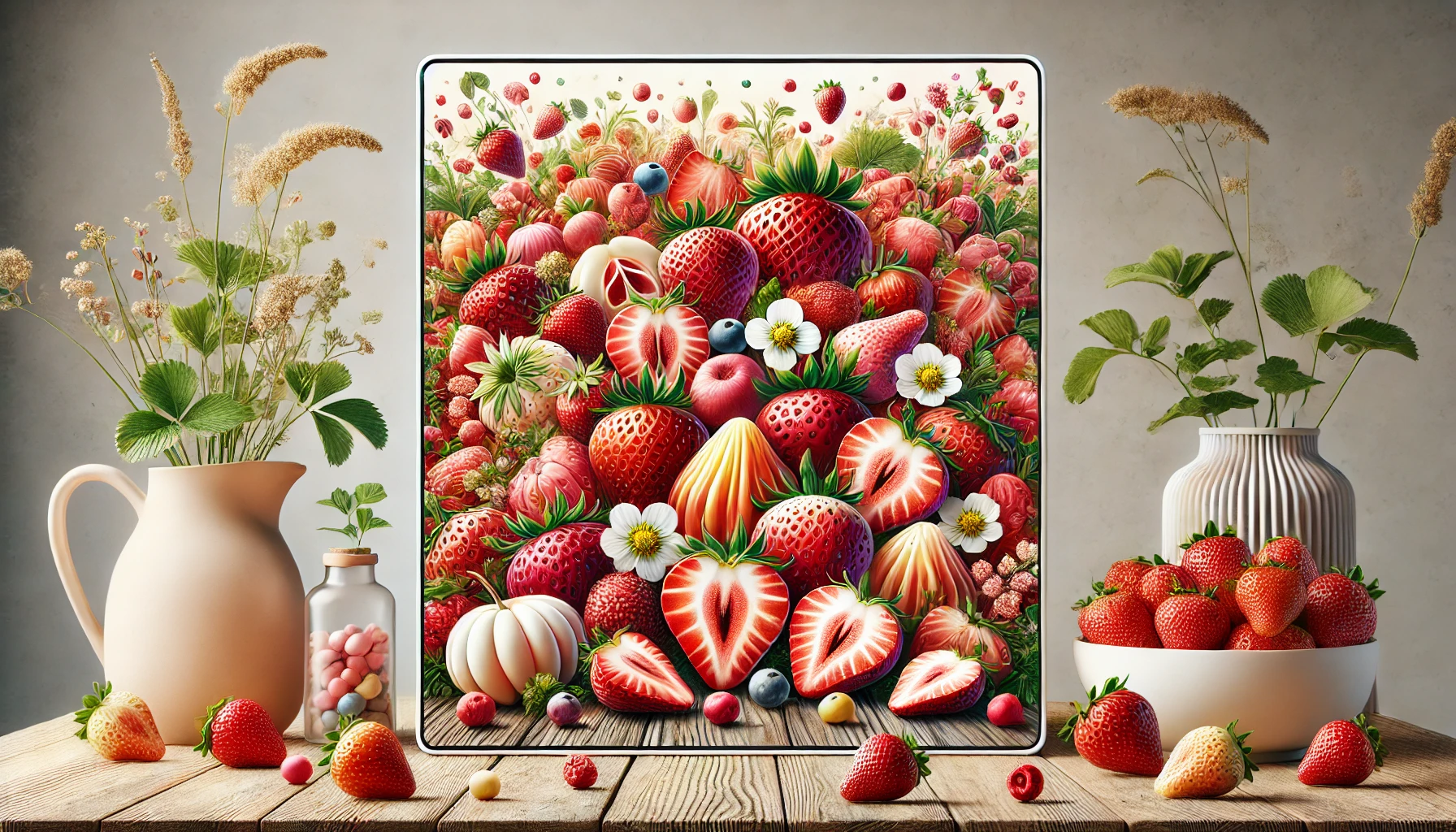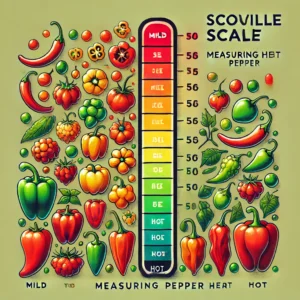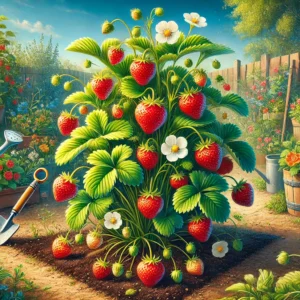Strawberries come in several varieties, with over 600 varieties, each with its unique characteristics, advantages, and potential drawbacks. These varieties can be broadly categorized based on their fruiting habits and suitability for different types of gardening. Understanding these varieties can help you choose the best type of strawberry for your garden, whether you are growing them in pots, raised beds, or traditional garden plots.
Types of Strawberries
1. June-bearing Strawberries
June-bearing strawberries produce one large crop in late spring or early summer. These strawberries are usually large and sweet, making them ideal for fresh eating and desserts. Some popular June-bearing varieties include Chandler, Honeoye, and Jewel.
2. Everbearing Strawberries
Everbearing strawberries produce two to three smaller harvests throughout the year, typically in late spring, late summer, and early fall. This type is perfect for gardeners who want a steady supply of strawberries. Popular everbearing varieties include Ozark Beauty, Everest, and Seascape.
3. Day-neutral Strawberries
Day-neutral strawberries produce fruit continuously throughout the growing season, as long as temperatures remain between 35°F and 85°F. These varieties are great for regions with mild summers. Some well-known day-neutral varieties are Albion, Tristar, and Monterey.
Popular Strawberry Varieties
Here are 20 popular varieties of strawberries:
1. Albion
– Description: Large, conical, and firm berries with a bright red color.
– Flavor Profile: Sweet and juicy with a high sugar content.
– Growing Conditions: Thrives in a wide range of climates.
– Uses: Excellent for fresh eating, desserts, and preserves.
2. Seascape
– Description: Medium to large, firm berries with a bright red color.
– Flavor Profile: Sweet with a hint of tartness.
– Growing Conditions: Performs well in various climates.
– Uses: Suitable for fresh consumption and freezing.
3. **Chandler
– **Description**: Large, firm berries with a deep red color.
– **Flavor Profile**: Sweet and juicy.
– **Growing Conditions**: Prefers warmer climates.
– **Uses**: Ideal for fresh eating and desserts.
4. **Allstar**
– **Description**: Large, juicy, and firm berries with a glossy red color.
– **Flavor Profile**: Sweet with a slight tartness.
– **Growing Conditions**: Adaptable to various climates.
– **Uses**: Great for fresh consumption and freezing.
5. **Ozark Beauty**
– **Description**: Medium-sized, bright red berries.
– **Flavor Profile**: Sweet and juicy.
– **Growing Conditions**: Performs well in most climates.
– **Uses**: Perfect for fresh eating and desserts.
6. **Camarosa**
– **Description**: Large, firm berries with a bright red color.
– **Flavor Profile**: Sweet and flavorful.
– **Growing Conditions**: Thrives in warmer regions.
– **Uses**: Excellent for fresh consumption and processing.
7. **Honeoye**
– **Description**: Large, bright red berries.
– **Flavor Profile**: Tangy and sweet.
– **Growing Conditions**: Prefers cooler climates.
– **Uses**: Ideal for fresh eating and freezing.
8. **Jewel**
– **Description**: Large, glossy berries with a bright red color.
– **Flavor Profile**: Sweet and juicy.
– **Growing Conditions**: Performs well in various climates.
– **Uses**: Great for fresh consumption and market sales.
9. **Mara des Bois**
– **Description**: Small to medium, aromatic berries.
– **Flavor Profile**: Sweet and fragrant.
– **Growing Conditions**: Suitable for cooler regions.
– **Uses**: Perfect for gourmet dishes and fresh eating.
10. **Tristar**
– **Description**: Medium-sized, bright red berries.
– **Flavor Profile**: Sweet with a slight tartness.
– **Growing Conditions**: Performs well in various climates.
– **Uses**: Suitable for fresh consumption and desserts.
11. **Monterey**
– **Description**: Large, firm berries with a bright red color.
– **Flavor Profile**: Sweet and juicy.
– **Growing Conditions**: Thrives in mild climates.
– **Uses**: Excellent for fresh eating and processing.
12. **Sweet Charlie**
– **Description**: Medium to large, sweet berries.
– **Flavor Profile**: Very sweet and juicy.
– **Growing Conditions**: Prefers warmer climates.
– **Uses**: Great for fresh consumption and desserts.
13. **Earliglow**
– **Description**: Medium-sized, bright red berries.
– **Flavor Profile**: Sweet and tangy.
– **Growing Conditions**: Adaptable to various climates.
– **Uses**: Ideal for fresh eating and freezing.
14. **Festival**
– **Description**: Large, firm berries with a bright red color.
– **Flavor Profile**: Sweet and juicy.
– **Growing Conditions**: Thrives in warmer regions.
– **Uses**: Perfect for fresh consumption and market sales.
15. **Sonata**
– **Description**: Large, glossy berries with a bright red color.
– **Flavor Profile**: Sweet and aromatic.
– **Growing Conditions**: Performs well in various climates.
– **Uses**: Great for fresh eating and desserts.
16. Diamante
– Description: Large, firm berries with a bright red color.
– Flavor Profile: Sweet and flavorful.
– Growing Conditions: Thrives in mild climates.
– Uses: Excellent for fresh consumption and processing.
17. Aromas
– Description: Medium to large, firm berries.
– Flavor Profile: Sweet with a hint of tartness.
– Growing Conditions: Adaptable to various climates.
– Uses: Suitable for fresh consumption and freezing.
18. Evie 2
– Description: Medium-sized, bright red berries.
– Flavor Profile: Sweet and juicy.
– Growing Conditions: Performs well in various climates.
– Uses: Great for fresh eating and desserts.
19. Selva
– Description: Large, firm berries with a bright red color.
– Flavor Profile: Sweet and flavorful.
– Growing Conditions: Thrives in mild climates.
– Uses: Ideal for fresh consumption and processing.
20. Ventana
– Description: Large, firm berries with a bright red color.
– Flavor Profile: Sweet and juicy.
– Growing Conditions: Prefers warmer climates.
– Uses: Excellent for fresh consumption and market sales.
Growing Tips for Strawberries
Soil Preparation
Strawberries grow best in well-drained, sandy soil with a pH between 5.5 and 6.5. Add organic matter like compost to enrich the soil. Ensure the soil is loose and free from weeds before planting.
Planting
Plant strawberries in early spring, after the last frost. Space plants about 18 inches apart to allow for growth and good air circulation. Plant them in raised beds or rows, ensuring the crown is just above the soil surface.
Care
Water strawberries regularly, about 1 inch per week, to keep the soil consistently moist but not waterlogged. Mulch around the plants with straw or pine needles to retain moisture, regulate soil temperature, and prevent weeds.
Fertilization
Apply a balanced fertilizer at planting time and again after the first harvest. Avoid over-fertilizing, as it can lead to excessive leaf growth and fewer berries.
Pest and Disease Control
Monitor your plants for common pests like aphids, slugs, and spider mites. Use organic or chemical controls as necessary. Prevent diseases by planting disease-resistant varieties and rotating crops annually.
Harvesting
Pick strawberries when they are fully red and ripe. Gently pull the berry from the stem, leaving the green cap attached. Harvest in the morning when berries are cool and refrigerate them immediately.
Health Benefits of Strawberries
Strawberries are packed with vitamins, minerals, and antioxidants. They are high in Vitamin C, which boosts your immune system, and they contain manganese, folate, and potassium. Strawberries are also rich in antioxidants, which help reduce inflammation and protect against chronic diseases.
Fun Facts About Strawberries
– Strawberries are the only fruit with seeds on the outside.
– There are over 200 seeds on the average strawberry.
– Strawberries belong to the rose family.
– The first garden strawberry was grown in France during the late 18th century.
Conclusion
Strawberries are not only delicious but also nutritious. With so many varieties to choose from, there is a perfect strawberry for everyone. Whether you prefer them sweet, tart, large, or small, you can enjoy strawberries in numerous ways. Try growing some in your garden or visit a local farm to explore and enjoy fresh, tasty strawberries.
References and Further Reading
– [Strawberry Plants](https://www.strawberryplants.org/)
– [Gardening Know How](https://www.gardeningknowhow.com/)
By exploring different varieties and understanding how to grow and enjoy them, you can make the most of this delightful fruit. Happy strawberry growing!6
1. June-bearing Strawberries
Specialty:
- Produce a large crop of berries over a 2-3 week period in late spring to early summer.
- Known for their large, flavorful berries.
Advantages:
- Ideal for traditional garden plots due to their vigorous growth and high yield.
- Excellent for making preserves and freezing due to the concentrated harvest period.
Disadvantages:
- Only one harvest per year, limiting the availability of fresh berries.
- Requires more space and proper planning to accommodate their extensive root systems and runners.
2. Ever-bearing Strawberries
Specialty:
- Produce two main crops per year: one in early summer and another in late summer or early fall.
- Berries are slightly smaller but have a sweet, intense flavor.
Advantages:
- Suitable for container gardening and small spaces due to their less aggressive spreading.
- Provides a longer harvesting period compared to June-bearing varieties.
Disadvantages:
- Smaller overall yield compared to June-bearing strawberries.
- Plants may require more maintenance and care to ensure continuous production.
3. Day-neutral Strawberries
Specialty:
- Produce fruit continuously from late spring until the first frost.
- Berries are generally smaller but have a consistent flavor and quality.
Advantages:
- Ideal for raised beds and containers as they do not produce as many runners.
- Continuous fruiting allows for a steady supply of fresh berries throughout the growing season.
Disadvantages:
- Lower yield per plant compared to June-bearing varieties.
- Plants may have a shorter lifespan, requiring more frequent replacement.
4. Alpine Strawberries
Specialty:
- Produce small, intensely flavored berries continuously throughout the growing season.
- Often grown for their ornamental value as well as their fruit.
Advantages:
- Perfect for container gardening, rock gardens, and edging in flower beds due to their compact size.
- Require less space and maintenance, making them ideal for urban gardens.
Disadvantages:
- Berries are very small, making them less suitable for large-scale culinary uses.
- Lower yield per plant, though the unique flavor compensates for the smaller harvest.
5. Heirloom Strawberries
Specialty:
- Include traditional varieties that have been passed down through generations.
- Known for their unique flavors, textures, and historical significance.
Advantages:
- Ideal for gardeners interested in preserving biodiversity and cultivating plants with historical importance.
- Often have unique flavors that are superior to modern commercial varieties.
Disadvantages:
- May be more susceptible to diseases and pests.
- Yield and fruit size can vary widely, and plants may require more care and attention.
Each strawberry variety offers unique benefits and challenges, making it important to choose the right type for your specific gardening conditions and goals. Whether you prefer the large, concentrated harvest of June-bearing strawberries, the continuous production of day-neutral varieties, or the unique flavors of heirloom and alpine strawberries, there’s a variety to suit every gardener’s needs. By understanding the specialties, advantages, and disadvantages of each type, you can enjoy a successful and rewarding strawberry-growing experience.



